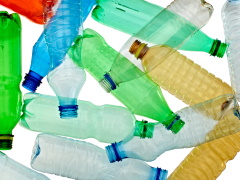Features
Various alternative options
Date: 2020-06-12 12:06:22.0
Author: Jon Evans

Plastic bottles.
Photo: Picsfive/Shutterstock.
The bioplastic polyethylene furandicarboxylate (PEF) is specifically being developed as an alternative to polyethylene terephthalate (PET), one of the world’s most important plastic materials, with around 50 million tonnes produced each year, one third of which is used to produce plastic bottles. But in many ways PEF is actually a superior material to PET, boasting high translucency, stiffness and chemical stability and better thermal, mechanical and barrier properties. The problem, as with many bioproducts, is that PEF is more expensive to produce than PET.
The current method for producing PEF involves catalytically converting the sugar fructose into a furan molecule called furandicarboxylic acid (FDCA), which is then reacted with ethylene glycol, derived from ethanol, to produce PEF. For over 10 years, the Dutch company Avantium has been developing this process for eventual commercial production, but the path has proved anything but smooth.
In 2016, Avantium formed a joint venture called Synvina with the German chemical giant BASF to commercialize its PEF technology, which would include building a commercial production plant with an annual capacity of 50,000 tonnes a year at BASF’s Verbund site in Antwerp, Belgium. But at the end of 2018, BASF announced that it was withdrawing from the joint venture.
Despite this setback, Avantium still has partnerships with various companies, including Mitsui, Danone and Carlsberg, for the development of PEF bottles and films. Together with 10 other companies, including LEGO Systems and Henkel, it is also part of the PEFerence consortium, an EU flagship project to develop an innovative PEF supply chain. At the end of 2019, this consortium was awarded a €25 million grant from the EU’s Bio-based Industries Joint Undertaking. Avantium is now looking to raise a further €150 million to fund the development of a commercial plant for producing FDCA and PEF, which it hopes will begin operating in 2023.
Others, meanwhile, are investigating alternative ways to produce PEF, which offer the promise of being cheaper and more sustainable. One option is to replace the metal-based polymerization catalysts required for reacting FDCA with ethylene glycol. Not only do these catalysts require high temperatures, but the metals in them can become incorporated into the PEF, adding unwanted color and reducing thermal stability.
In a paper last year in ChemSusChem, Katja Loos and her team at the University of Groningen in the Netherlands reported swapping the catalysts for a commercially available lipase enzyme, which they used to produce a range of PEF-like furan-based copolymers. In another paper from last year in ChemSusChem, a team of Chinese scientists led by Jun Tang at Jilin University reported swapping the metal catalyst for an ionic liquid, which worked just as well.
Now, Andrew Smallbone and his team at Durham University have investigated another option for making PEF production cheaper and more sustainable, by designing a process for producing FDCA from biowaste and carbon dioxide rather than fructose. As Smallbone and his team report in a paper in Nature Sustainability, their process starts with the group of hemicelluloses known as xylan, which can be obtained from plant biomass. In a four-step process, this xylan is converted to furfural, then 2-furoic acid, which can be reacted with carbon dioxide to produce FDCA. Finally, the FDCA is reacted with ethylene glycol to produce PEF.
All the steps in this process are either well established or have been demonstrated in the laboratory or a pilot plant, but Smallbone and his team are the first to propose stringing them all together. They have yet to be demonstrate the process practically, but they have conducted a detailed life-cycle analysis of it. This revealed that, compared with conventional PET production, the process should reduce energy consumption and greenhouse gas emissions by up to 40.5%, showing the important environmental benefits offered by PEF. And these environmental benefits could be even greater if the catalysts required for the process were to be replaced by enzymes or ionic liquids.
The views represented here are solely those of the author and do not necessarily represent those of John Wiley and Sons, Ltd. or of the SCI.
Displaying 2 keywords used to tag this article:
- Jules Audemars-Australia Best Quali
- DG6582 Mens Moncler Down Jackets Gr
